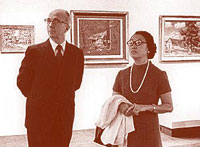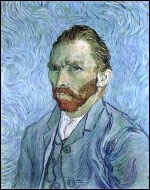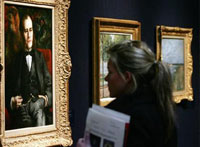Art Investing Advice from Dr. Lori
Art Smart: Smart Decisions for Art Investors
 In many of my Art Advice columns, I will discuss topics that relate to buying art for investment. There are a few basic things to remember when you are considering an art purchase for investment.
In many of my Art Advice columns, I will discuss topics that relate to buying art for investment. There are a few basic things to remember when you are considering an art purchase for investment.
This Art Advice column will concentrate on the role of the artist in your fine art purchases and the artist's importance in terms of your investment. In another Art Advice column, I deal with the topic of buying works on paper and the investment impact. In forthcoming columns, I'll discuss the investment issues such as: age, subject matter, style, and media.
The Artist's Role within your Investment Strategy
Of course, the artist plays a vital role in the scope of a work of art. Yet, in addition to the quality of the piece that an artist creates, other factors also carry weight in terms of the artist. He or she is key to your art investment strategy. Primarily, the basic factors including your collecting goals, enjoyment for a piece, interest, and quality should dictate your decision to buy a work of art. Make certain that the work meets the standards for presentation and condition and then, assess the other criteria.
 As for the artist, the artist's general background is important. This certainly impacts the value of the piece. In basic terms, this means that the artist's background or his or her training and art teachers, degrees completed, and other credentials are important. Points such as an artist's exhibition record (how often and where do they show their work?), and the sales or commercial record come into play when determining value and investment return. Most of us understand the concept that, in simple terms, a work of art by an established artist is worth more than a piece by a lesser known artist. For instance, a Van Gogh usually commands higher prices at auction than a work by someone less well known, like Joe Smith. This is a simple concept.
As for the artist, the artist's general background is important. This certainly impacts the value of the piece. In basic terms, this means that the artist's background or his or her training and art teachers, degrees completed, and other credentials are important. Points such as an artist's exhibition record (how often and where do they show their work?), and the sales or commercial record come into play when determining value and investment return. Most of us understand the concept that, in simple terms, a work of art by an established artist is worth more than a piece by a lesser known artist. For instance, a Van Gogh usually commands higher prices at auction than a work by someone less well known, like Joe Smith. This is a simple concept.
Art is like anything else that can be marketed. We want the "brand name" or the popular artist's work or at least we are made to believe we want it through marketing. This is why we have to conduct some research before we buy.
Art Investing: Dead or Alive?
We are also aware that in most cases, the price and value of a work of art by a dead artist is higher than that of a living artist. This is another simple point that makes sense to most of us since it's hard to get a new Joe Smith painting once he has passed on.
Let's dispell some myths. The smart collector doesn't get hung up on this point about dead versus living artists. The smart collector considers the quality of the work and the fact that the contemporary art market is much more forgiving than the old guard. If you like a work of art by a living artist, you have some good options in terms of price and availability. This is not always the case with long-established, often dead artists since there are usually fewer works from which to choose and very little room for price negotiations.
The impact of Teachers, Mentors, and Credentials
Having presented some of the obvious information, we get to the lesser known aspects of the art world and the specifics of an artist's role in evaluating art. An artist's teachers, art training, credentials, exhibition record and sales information all have an important impact on the value of that artist's work. For instance, teachers, art school participation, and credentials such as the degree of Master of Fine Art (MFA) sometimes help to increase the value of an artist's work. Degrees are not the only standards since enjoying the work is important too. So, don't just search for the sheepskin but enjoy the piece too.
 For instance, if an artist studied and worked under a master painter or sculptor, for instance, his work usually carries more value. Famous teachers (and their reputation) often times help their less-than-famous artist pupils. If an artist, better yet, was one of only a few students of a master painter or sculptor, that artist's work is even more sought after. A good investment. A good example of this is the teacher/student relationship of Thomas Hart Benton and Jackson Pollock. Good artists usually produce successful students.
For instance, if an artist studied and worked under a master painter or sculptor, for instance, his work usually carries more value. Famous teachers (and their reputation) often times help their less-than-famous artist pupils. If an artist, better yet, was one of only a few students of a master painter or sculptor, that artist's work is even more sought after. A good investment. A good example of this is the teacher/student relationship of Thomas Hart Benton and Jackson Pollock. Good artists usually produce successful students.
From the topic of teachers, we arrive at the topic of art schools. Remember, the art world is not so far removed from the rest of the world, really. For instance, as you might expect some art schools, just like colleges and universities, are better than others. We are quite familiar with this notion and it is no different in the art world.
For instance, in the 18th & 19th centuries, the idea of studying abroad or attending an art academy carried a great deal of prestige for the artist. This remained true in terms of determining a value for such an artist's work. Today, artists take the Grand Tour and also attend art schools or MFA programs at colleges and universities.
Staying on Course
The artist's style is also of interest. Maintaining a characteristic or well known style is also a serious point of interest for collectors. For example, assume that there is a hypothetical artist named Joe Smith who paints portraits of his dog, Ed. The pictures of Ed are of a good quality and are appropriately exhibited and collected. People start to recognize Ed and equate the pictures of Ed with Joe Smith's art. People purchase the Ed paintings by Joe Smith and they come to recognize the works as Smiths, too.
One day, Joe Smith decides to stop painting Ed and start painting landscapes. He produces fine quality landscapes but then he decides to try his hand at still life compositions. If you own a Joe Smith painting of Ed, Joe Smith's decision to try a new direction (or the effect of exhibition exposure and marketing of Ed paintings) has resulted in an increase in value for your work because you own the better known and characteristic style of painting by Joe Smith. For a Joe Smith painting, the value remains in the Ed paintings until a time when his landscapes or still lifes have enjoyed the exhibition and sales success that the Ed paintings have amassed.
Also, an artist's change in interest or direction does not automatically mean that there is no value to works in the new style or technique. It is just a safer bet to consider a mature and characteristic work by an artist rather than a work which shows a point of departure. For deceased artists, scholarship drives the market as does commercial interest in a type or period of paintings by a specific artist.
I am happy to report that this Art Advice column was provided in response to an inquiry from a new collector and Masterpiece Technologies Inc. visitor. I hope this information proves helpful and thanks for the questions. Please feel free to contact me with any questions.
Dr. Lori
Director, Masterpiece Technologies Inc.